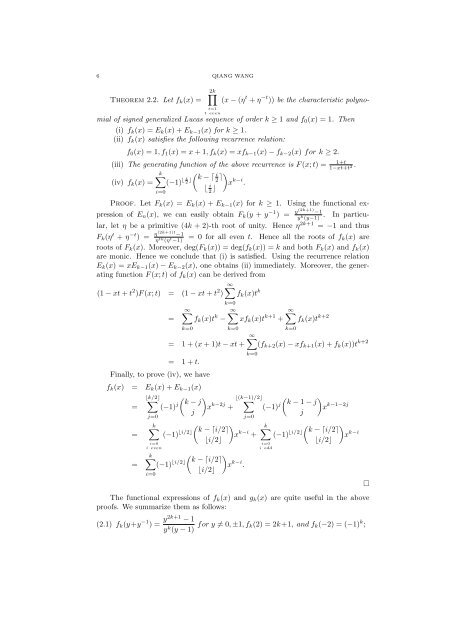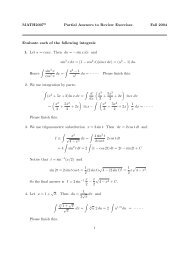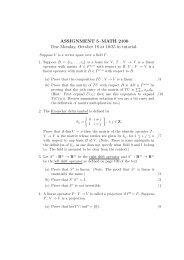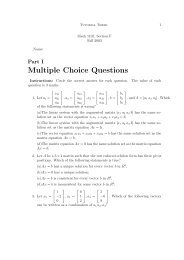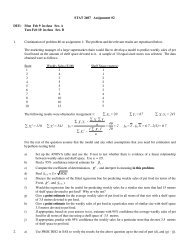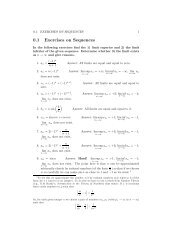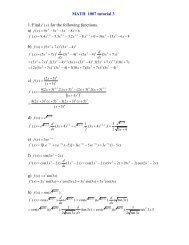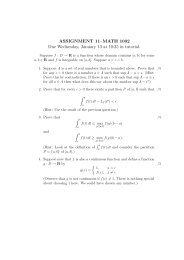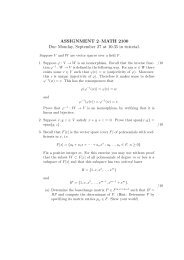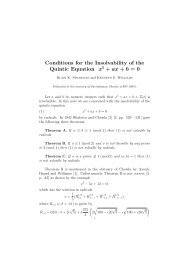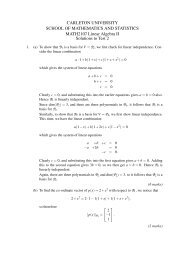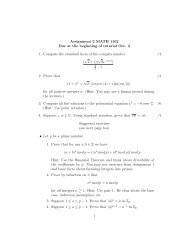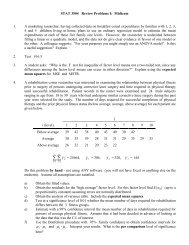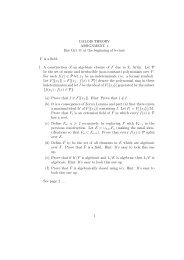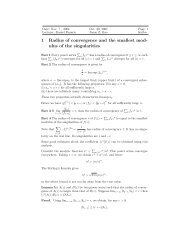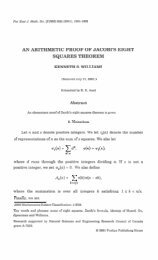On generalized Lucas sequences - Mathematics and Statistics ...
On generalized Lucas sequences - Mathematics and Statistics ...
On generalized Lucas sequences - Mathematics and Statistics ...
You also want an ePaper? Increase the reach of your titles
YUMPU automatically turns print PDFs into web optimized ePapers that Google loves.
6 QIANG WANG<br />
Theorem 2.2. Let fk(x) =<br />
2k<br />
t=1<br />
t even<br />
(x − (η t + η −t )) be the characteristic polyno-<br />
mial of signed <strong>generalized</strong> <strong>Lucas</strong> sequence of order k ≥ 1 <strong>and</strong> f0(x) = 1. Then<br />
(i) fk(x) = Ek(x) + Ek−1(x) for k ≥ 1.<br />
(ii) fk(x) satisfies the following recurrence relation:<br />
f0(x) = 1, f1(x) = x + 1, fk(x) = xfk−1(x) − fk−2(x) for k ≥ 2.<br />
(iii) The generating function of the above recurrence is F (x; t) = 1+t<br />
1−xt+t2 .<br />
k<br />
i ⌊<br />
(iv) fk(x) = (−1) 2 ⌋<br />
i k − ⌈ 2⌉ <br />
x k−i .<br />
i=0<br />
⌊ i<br />
2 ⌋<br />
Proof. Let Fk(x) = Ek(x) + Ek−1(x) for k ≥ 1. Using the functional expression<br />
of En(x), we can easily obtain Fk(y + y−1 ) = y(2k+1) −1<br />
yk . In particu-<br />
(y−1)<br />
lar, let η be a primitive (4k + 2)-th root of unity. Hence η2k+1 = −1 <strong>and</strong> thus<br />
Fk(η t + η −t ) = η(2k+1)t −1<br />
η tk (η t −1) = 0 for all even t. Hence all the roots of fk(x) are<br />
roots of Fk(x). Moreover, deg(Fk(x)) = deg(fk(x)) = k <strong>and</strong> both Fk(x) <strong>and</strong> fk(x)<br />
are monic. Hence we conclude that (i) is satisfied. Using the recurrence relation<br />
Ek(x) = xEk−1(x) − Ek−2(x), one obtains (ii) immediately. Moreover, the gener-<br />
ating function F (x; t) of fk(x) can be derived from<br />
(1 − xt + t 2 )F (x; t) = (1 − xt + t 2 ∞<br />
) fk(x)t k<br />
=<br />
k=0<br />
k=0<br />
∞<br />
fk(x)t k ∞<br />
− xfk(x)t k+1 ∞<br />
+ fk(x)t k+2<br />
k=0<br />
= 1 + (x + 1)t − xt +<br />
= 1 + t.<br />
Finally, to prove (iv), we have<br />
j=0<br />
k=0<br />
∞<br />
(fk+2(x) − xfk+1(x) + fk(x))t k+2<br />
fk(x) = Ek(x) + Ek−1(x)<br />
=<br />
⌊k/2⌋ <br />
(−1) j<br />
<br />
k − j<br />
x<br />
j<br />
k−2j ⌊(k−1)/2⌋ <br />
+ (−1) j<br />
<br />
k − 1 − j<br />
x<br />
j<br />
k−1−2j<br />
=<br />
=<br />
i=0<br />
i even<br />
k=0<br />
j=0<br />
k<br />
(−1) ⌊i/2⌋<br />
<br />
k − ⌈i/2⌉<br />
x<br />
⌊i/2⌋<br />
k−i +<br />
k<br />
(−1) ⌊i/2⌋<br />
<br />
k − ⌈i/2⌉<br />
x<br />
⌊i/2⌋<br />
k−i .<br />
i=0<br />
k<br />
(−1) ⌊i/2⌋<br />
<br />
k − ⌈i/2⌉<br />
x<br />
⌊i/2⌋<br />
k−i<br />
i=0<br />
i odd<br />
The functional expressions of fk(x) <strong>and</strong> gk(x) are quite useful in the above<br />
proofs. We summarize them as follows:<br />
(2.1) fk(y+y −1 ) = y2k+1 − 1<br />
y k (y − 1) for y = 0, ±1, fk(2) = 2k+1, <strong>and</strong> fk(−2) = (−1) k ;


